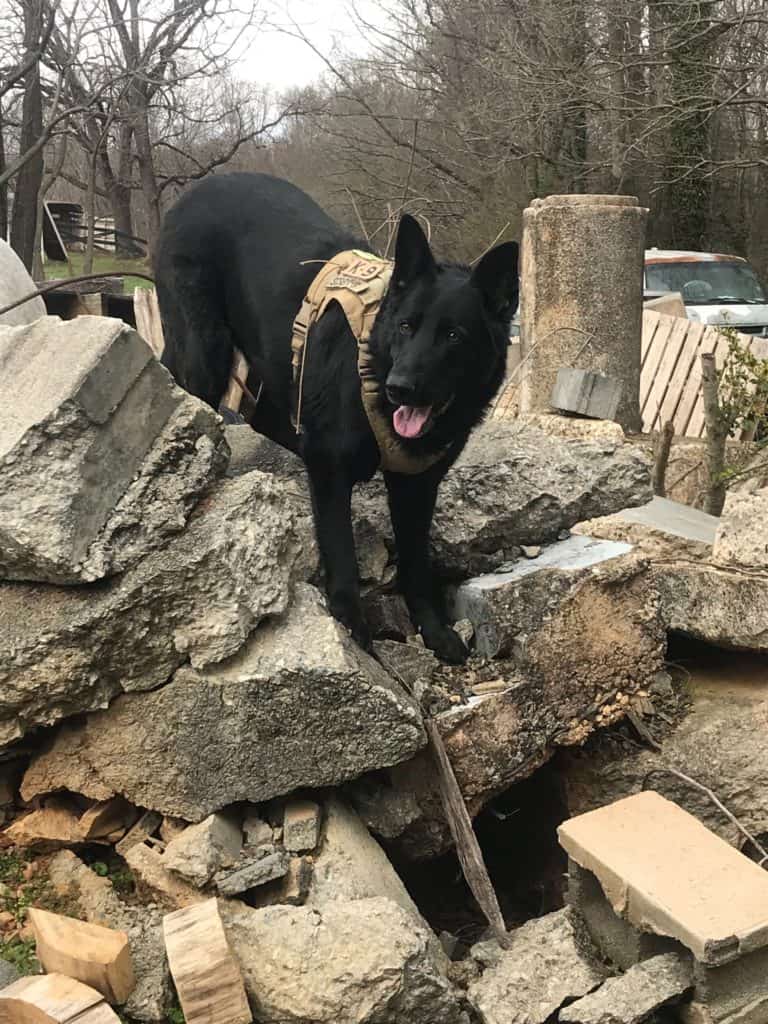Cadaver Dogs
Human remains detection (HRD) K9s help locate forensic evidence and bring closure to families
Recovering deceased victims at accidents, natural disasters, crime scenes or at scenes of terrorism is always a difficult and challenging task. It is, however, a critical part of helping to bring closure to families affected by tragedy.
In many missing people cases, locating deceased individuals is not a straightforward process and can even take years or decades. Whether someone was a victim in a civilian search and rescue missing person deployment, or was the tragic victim of a homicide case, it may be difficult to locate their body. Cadaver dogs are an incredible tool for locating difficult to find victims, and can make the process of locating these victims significantly faster and more discreet than other recovery methods.
We offer cadaver dogs that are impeccably trained to work independently in a variety of demanding field environments to ensure that they can reliably identify and locate any human remains present and reduce the work of human searchers. Our cadaver dogs can be trained to locate human remains in vehicles, buildings, wooded areas and even in water. We also offer first class educational programs and training for cadaver dog handlers.
Our cadaver dogs are thoroughly evaluated for job specific suitability, environmental stability and physical soundness. These dogs are expected to search for anywhere from minutes to hours, oftentimes in difficult terrain, and we ensure that each cadaver dog that we train is fully capable of doing its job effectively regardless of their deployment environment.
Our cadaver dogs are trained to detect the following substances:
- Flesh
- Bone (dry and wet)
- Blood
- Teeth
- Hair
- Combination human remains odors

We can provide German Shepherds, Belgian Malinois, Labrador Retrievers and Golden Retrievers as well as other breeds of Police K9s upon request. Cadaver dogs (also known as Human Remains Detection, or HRD dogs) are trained to locate various types and amounts of human remains. This helps ensure that a dog will be capable of effectively locating target odor regardless of how long a body has aged, or whether or not it is still fully in tact. Cadaver dogs are also trained to indicate on human remains in varying states of decomposition. Cadaver dogs can be trained to indicate with a passive (sit) or active (scratch) alert.
All of our cadaver dogs are trained to locate human remains on land, whether the target odor is at ground level, suspended or buried. For an additional fee, we also offer water cadaver dog training, which is used to locate human remains in aquatic environments such as lakes, ponds, rivers or streams. In addition to human remains detection, our cadaver dog training also covers obedience and practical agility. Our cadaver dogs are trained to nationally recognized standards.
We offer a two-year health guarantee and include x-rays on all of our cadaver dogs. The purchase of a human remains detection dog also includes a 3-week Police K9 Handler Course of instruction, lodging at our dog training center, certification, course materials and free in service training and annual re-certification. Refresher training is available for as long as you own the dog.
Contact us today for more information!
K9 Handler Training
Our handler training programs provide you with the confidence, knowledge and skills you need to get results in the field.
During our Cadaver Dog Handler Training Courses, we ensure that our dog teams are completely confident and well trained in handling and maintaining their cadaver dog. In addition to learning the necessary skills to be an effective canine handler, we also cover human decomposition, obtaining and maintaining training aids, and crime scene management.
Our Cadaver Dog Handler Course is a comprehensive course taught by current and former law enforcement K9 handlers and supervisors that teaches beginner handlers all they need to know to be safe and effective in the field. For experienced handlers, our handler courses can be customized to assist them in honing their existing skills. Listed below are some of the topics covered during our Cadaver Dog Handler Courses:
Basic Odor Theory
Human Decomposition
Proper Handling Techniques
Record Keeping & Report Writing
Canine First Aid & CPR
Proper Detection Training Aid Handling and Storage
Cadaver Dogs in Aquatic Environments
Obtaining and Maintaining Training Aids
What Are The Benefits Of A Cadaver Dog?
Cadaver dogs are a valuable asset for law enforcement teams – they are able to search vast areas in a shorter period of time, and their accuracy for detecting human remains is unmatched. Learn more about the benefits of a well-trainined cadaver dog.
Helps locate forensic evidence necessary to close court cases
Cadaver dogs are able to locate minute amounts of physical evidence that would be nearly impossible to locate, as well as locate bodies buried several feet under the ground. This makes them a valuable resource when searching for victims of murder and homicide cases.
Their incredible olfactory systems can detect well concealed target odors, and very faint odors which would otherwise be undetectable. Cadaver dogs provide a highly accurate method of detecting the evidence necessary to close court cases and bring justice to victims who were tragically lost at the hands of another.
Brings closure to loved ones
When an individual goes missing, their family typically suffers the most intensely. It can be tormenting and traumatic to lose a loved one and not know what happened to them, or if they are still alive.
Cadaver dogs are often the most effective - and fastest - method of locating deceased individuals. Finding a family’s lost loved one as soon as possible provides the closure necessary to heal, while also allowing them to put their loved one to rest.
Accurate and efficient
Studies have demonstrated that most well-trained cadaver dogs have an accuracy rate of between 95%-98%, making them the most accurate tool available in locating human remains. In cases where the location of a body is not known, these dogs often mean the difference between successfully finding a body and not finding it.
Cadaver dogs are also the most efficient method of locating human remains in instances where their exact location is not already known. They can cover a significant amount of ground in a relatively short duration of time, while being able to detect bodies which are buried or otherwise undetectable. One handler and their dog often attracts significantly less public attention than a large number of human ground pounders physically searching for visible signs of a body.
Non-invasive and cost effective
Cadaver dogs provide a highly non-invasive method for locating bodies which are buried or unaccessible. In cases where a body is buried, other methods require physically altering the environment in order to locate a body. Sometimes this process requires significant excavation efforts which may or may not be successful. In instances where probing or excavation are not necessary, many people may be used to search for a body. This technique often attracts a great deal of attention and can be very disruptive for people living in the local area.
Cadaver dogs are also more cost effective than many other forms of locating difficult to find bodies. Since olfactometers are incredibly expensive and cannot easily be moved, they are not often used to locate bodies. Other methods can be highly invasive and expensive. A cadaver dog is a highly cost-effective method of locating deceased individuals in an effective and non-invasive manner.
Improve the capability of your team today!
Cadaver Dog Statistics
Due to their proven accuracy, the work of human remains detection (HRD) dogs is necessary and valuable to help assist law enforcement and bring closure to families.

Cadaver dogs are scientifically proven to be accurate.
One of the most recent studies on the accuracy of cadaver dogs was performed in 2008. This study concluded that a well-trained cadaver dog is capable of locating fresh and aged human remains with an accuracy rate of between 95%-98%.
Source: Institute of Legal Medicine, University Medical Center Hamburg, Germany

Annually, over 500,000 people are reported as missing in the United States.
According to the National Crime Information Center, the United States has one of the highest numbers of missing persons in the world. In 2021 alone, they reported 521,705 missing, with 93,718 still missing at the beginning of 2022.
